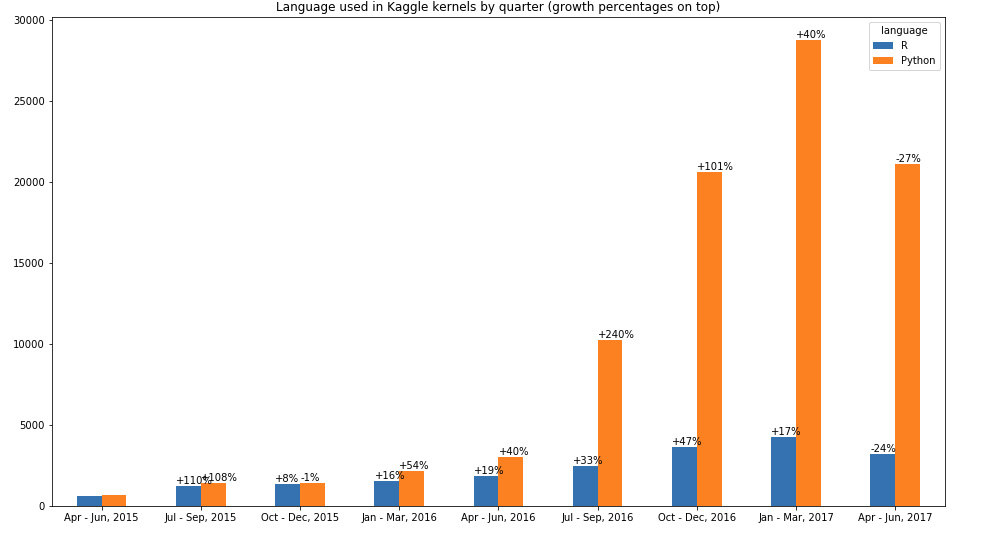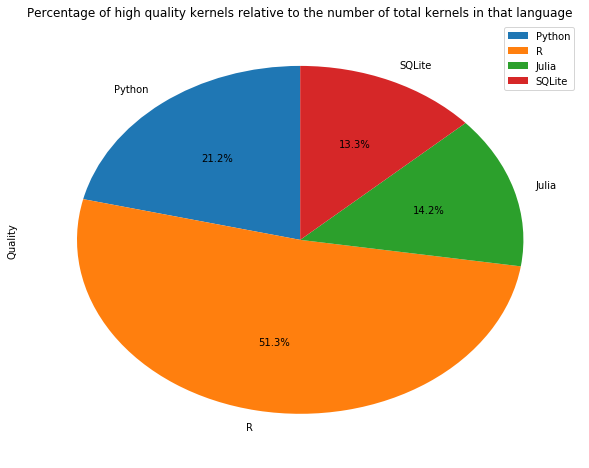TL;DR; Python is king, but R kernels are more likely to win medals.
The kernels feature on kaggle.com was introduced around March 2015 and became quickly popular among data scientists. In 2017, in every month almost 10.000 new kernels are created. So I was curious what language do devs use on kaggle.
Kaggle does not provide an api, so to get the data about kernels I had to scrape the website, which returned 114.896 kernels.
Show the code
1
2
3
4
5
6
7
8
9
10
11
12
13
14
15
16
17
18
19
20
21
22
23
24
25
26
27
28
29
30
31
32
33
34
35
36
37
38
import scrapy
import json
import logging
from w3lib.url import add_or_replace_parameter
import re
class MySpider(scrapy.Spider):
name = 'myspider'
start_urls = ['https://www.kaggle.com/kernels/all/20?sortBy=date&after=false']
page = 0
ids = []
def parse(self, response):
data = json.loads(str(response.body, 'utf-8'))
for item in data:
finalData = {
"language": item["languageName"],
"comments": item["totalComments"],
"votes": item["totalVotes"],
"medal": item["medal"],
"id": item["id"],
"date": item["scriptVersionDateCreated"]
}
id = item["id"]
yield finalData
if id not in self.ids:
self.ids.append(id)
else:
logging.info("The id is duplicate, stop here")
return
if data[len(data) - 1]["id"]:
self.page += 20
if self.page > 1000:
self.page = 1000
url = add_or_replace_parameter(response.url, 'after', data[len(data) - 1]["id"])
url = re.sub(r"([0-9]){1,9}(?=\?)", str(self.page), url)
yield scrapy.Request(url, self.parse)
From the chart bellow we can see that R and Python were used almost equally at first but then at the beginning of 2016 Python started to grow much more rapidly then R. The other 2 languages (Julia and SQLite) were not used often enough to be meaningful in the chart.

Show the code
1
2
3
4
5
6
7
8
9
10
11
12
13
14
15
16
17
18
19
20
21
22
23
24
25
26
27
28
29
30
31
32
33
34
35
36
37
38
39
40
41
42
import pandas as pd
import matplotlib.pyplot as plt
import numpy as np
import datetime
%matplotlib inline
def dateparse(date) -> str:
date = date.split("-")
return "%s-%s" % (date[0], date[1])
kernels_data = pd.read_csv(
"data\kaggle\all_data.csv",
parse_dates=["date"],
date_parser=dateparse
)
languages = kernels_data[["date", "language"]]
languages = languages.groupby(["date","language"]).size().to_frame("Total").unstack().resample("Q").sum()
def quarterlyMonthNmaes(x):
start_date = x.name - pd.offsets.MonthBegin(3)
final_date = str(start_date.strftime('%b')) + " - " + str(x.name.strftime('%b, %Y'))
return final_date
languages_quarterly = languages.copy()
languages_quarterly.index = languages["Total"].apply(quarterlyMonthNmaes, axis=1)
languages_python_r = languages_quarterly["Total"][["R", "Python"]]
languages_python_r.fillna(0, inplace=True)
languages_python_r.drop(languages_python_r.index[[0,10]], inplace=True)
def growth(current, previous):
increase = current - previous
if increase != 0.0 and previous != 0.0:
number = round(increase / previous * 100)
return '{0:{1}}'.format(number, '+' if number else '')
return 0
ax = languages_python_r.plot.bar(figsize=(16,9), rot=0, title="Language used in Kaggle kernels by quarter (growth percentages on top)")
for index, p in enumerate(ax.patches):
previous_height = ax.patches[index - 1].get_height()
if index == 0 or index == 9: continue
ax.annotate(str(growth(p.get_height(), previous_height)) + "%", ((p.get_x()), int(p.get_height() + 150)))
Maybe R kernels are of better quality? To see the quality of the kernels we can check how many medals did the kernels receive. We followed the Olympics rule of giving to gold medals 3 points, to silver 2 points and to bronze 1 point.


Show the code
1
2
3
4
5
6
7
8
9
10
11
12
13
14
15
16
17
18
19
20
21
22
23
24
25
26
27
28
29
30
31
32
33
34
35
36
37
38
medals = kernels_data[["date", "language", "medal"]]
def medals_to_points(x):
if x == "gold":
return 3
if x == "bronze":
return 1
if x == "silver":
return 2
return 0
medals.fillna(0, inplace=True)
medals_transformed = medals.copy()
medals_transformed["medal"] = medals_transformed["medal"].apply(medals_to_points)
python_nr_kernals = medals_transformed.loc[medals_transformed["language"] == "Python"].count().medal
r_nr_kernels = medals_transformed.loc[medals_transformed["language"] == "R"].count().medal
julia_nr_kernels = medals_transformed.loc[medals_transformed["language"] == "Julia"].count().medal
sql_nr_kernels = medals_transformed.loc[medals_transformed["language"] == "SQLite"].count().medal
medals_transformed_points = medals_transformed.groupby(["language"]).sum()
python_points = medals_transformed_points.loc["Python"].medal
r_points = medals_transformed_points.loc["R"].medal
julia_points = medals_transformed_points.loc["Julia"].medal
sql_points = medals_transformed_points.loc["SQLite"].medal
def medals_percentage(percent, whole):
return round((percent * 100.0) / whole, 1)
python_quality_kernels_percentage = medals_percentage(python_points, python_nr_kernals)
r_quality_kernels_percentage = medals_percentage(r_points, r_nr_kernels)
julia_quality_kernels_percentage = medals_percentage(julia_points, julia_nr_kernels)
sql_quality_kernels_percentage = medals_percentage(sql_points, sql_nr_kernels)
medals_graph = pd.DataFrame({"index": ["Nr of kernels", "Medal Points", "Percentage of quality kernels"], "R": [r_nr_kernels,r_points,r_quality_kernels_percentage], "Python": [python_nr_kernals,python_points,python_quality_kernels_percentage], "Julia": [julia_nr_kernels, julia_points, julia_quality_kernels_percentage], "SQLite": [sql_nr_kernels, sql_points, sql_quality_kernels_percentage] })
medals_graph.set_index("index", inplace=True)
quality_kernels = pd.DataFrame({"index": ["Python", "R", "Julia", "SQLite"], "Quality": [2.4, 5.8, 1.6, 1.5]}).set_index("index")
quality_kernels.plot.pie(figsize=(10,8), y = "Quality", title="Percentage of high quality kernels relative to the number of total kernels in that language",autopct='%1.1f%%',
startangle=90, shadow=False)
Python kernels got almost twice as many medals than R (2241 compared to 1235), but the percentage of quality kernels from total kernels is smaller for python. R has a longer history in data science and, arguably, R users have more experience in this field while Python is easier to learn and likely the language of choice for beginners in data science.
Most of the users are in OECD countries. Not all users make their location public or are honest. But from the top 3000 rated users, 852 say they are in USA. This map shows it better when we normalise according to total population:
Show the code
1
2
3
4
5
6
7
8
9
10
11
12
13
14
15
16
17
18
19
20
21
22
23
24
25
26
27
28
29
30
31
32
33
34
35
36
37
38
39
40
41
42
43
44
45
46
47
48
data = pd.read_csv(
"data/kaggle/users.csv",
parse_dates=["join_date"],
date_parser=dateparse
)
sort_countries = data.groupby("country").size().to_frame("Total").sort_values("Total", ascending=False)
# get data about countries and population
import json
with open('data/kaggle/population.json') as data_file:
population = json.load(data_file)
population_dict = {}
for x in population:
population_dict[x["country"]] = x["population"]
sort_countries["country"] = sort_countries.index.get_level_values('country')
sort_countries["population"] = sort_countries["country"].map(population_dict).astype(int)
countries_population = sort_countries.assign(
per_capita=lambda x: round(x["Total"] / x["population"] * 10000000, 2))
with open('data/kaggle/users_created.json', 'w') as f:
f.write(countries_population.to_json(orient='records'))
def get_3_code_country(country):
if (country == "South Korea"):
return "KOR"
elif (country == "North Korea"):
return "PRK"
else:
url = 'https://restcountries.eu/rest/v2/name/' + quote(country, safe='')
r = requests.get(url)
response = r.json()
try:
return response[0]['alpha3Code']
except KeyError:
return None
import requests
from urllib.parse import quote
data_javascript_map = countries_population.copy()
countries_population['iso_3'] = countries_population.country.apply(get_3_code_country)
with open('data/kaggle/users_created.json', 'w') as f:
f.write(countries_population[["country","iso_3","Total","per_capita"]].to_json(orient='records'))
Full code here.
